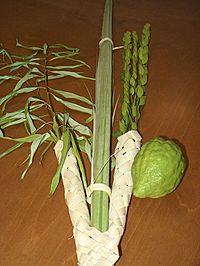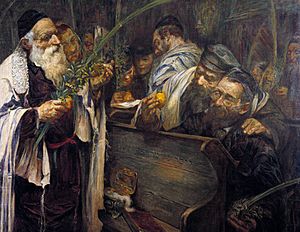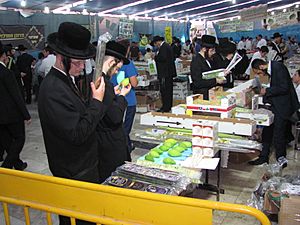Four species facts for kids

|
|
| Halakhic texts relating to this article | |
|---|---|
| Torah: | Leviticus 23:40 |
| Babylonian Talmud: | Sukkah Chapter 3 |
| Mishneh Torah: | Laws of Shofar, Sukkah, and Lulav 7:1–8:11 |
| Shulchan Aruch: | Orach Chaim 645–658 |
The four species (Hebrew: ארבעת המינים arba'at ha-minim, also called arba'a minim) are four plants mentioned in the Torah (Leviticus 23:40) as being relevant to the Jewish holiday of Sukkot. Observant Jews tie together three types of branches and one type of fruit and wave them in a special ceremony each day of the Sukkot holiday, excluding Shabbat. According to Rabbinic Judaism, the waving of the four plants is a mitzvah prescribed by the Torah, and it contains symbolic allusions to a Jew's service of God.
The four plants
The mitzvah of waving the four species derives from the Torah. In Leviticus, it states:
Leviticus 23:40 And you shall take on the first day the fruit of splendid trees, branches of palm trees and boughs of leafy trees and willows of the brook, and you shall rejoice before the LORD your God for seven days. English Standard Version
In Leviticus 23:40 the Hebrew terms for the four plants are:
- ‘êṣ hāḏār (עֵץ הָדָר), citrus trees
- təmārîm (תְּמָרִים), palm trees
- ‘êṣ ‘āḇōṯ (עֵץ עָבֹת), thick/leafy trees
- ‘arḇê-nāḥal (עַרְבֵי נַחַל), willows of the brook/valley
In Talmudic tradition, the four plants are identified as:
- etrog (אתרוג) – the fruit of a citron tree
- lulav (לולב) – a ripe, green, closed frond from a date palm tree
- hadass (הדס) – boughs with leaves from the myrtle tree
- aravah (ערבה) – branches with leaves from the willow tree
| Part of a series on | |||
|---|---|---|---|
|
|||
| Judaism | |||
| Category | |||
| Jewish religious movements | |||
| Orthodox (Haredi • Hasidic • Modern) | |||
| Conservative • Reform | |||
| Reconstructionist • Renewal • Humanistic | |||
| Jewish philosophy | |||
| Principles of faith • Kabbalah • Messiah • Ethics | |||
| Chosenness • Names of God • Musar | |||
| Religious texts | |||
| Tanakh (Torah • Nevi'im • Ketuvim) | |||
| Ḥumash • Siddur • Piyutim • Zohar | |||
| Rabbinic literature (Talmud • Midrash • Tosefta) | |||
| Religious Law | |||
| Mishneh Torah • Tur | |||
| Shulchan Aruch • Mishnah Berurah | |||
| Kashrut • Tzniut • Tzedakah • Niddah • Noahide laws | |||
| Holy cities | |||
| Jerusalem • Safed • Hebron • Tiberias | |||
| Important figures | |||
| Abraham • Isaac • Jacob | |||
| Moses • Aaron • David • Solomon | |||
| Sarah • Rebecca • Rachel • Leah | |||
| Rabbinic sages | |||
| Jewish life cycle | |||
| Brit • Pidyon haben • Bar/Bat Mitzvah | |||
| Marriage • Bereavement | |||
| Religious roles | |||
| Rabbi • Rebbe • Posek • Hazzan/Cantor | |||
| Dayan • Rosh yeshiva • Mohel • Kohen/Priest | |||
| Religious buildings & institutions | |||
| Synagogue • Beth midrash • Mikveh | |||
| Sukkah • Chevra kadisha | |||
| Holy Temple / Tabernacle | |||
| Jewish education | |||
| Yeshiva • Kollel • Cheder | |||
| Religious articles | |||
| Sefer Torah • Tallit • Tefillin • Tzitzit • Kippah | |||
| Mezuzah • Hanukiah/Menorah • Shofar | |||
| 4 Species • Kittel • Gartel | |||
| Jewish prayers and services | |||
| Shema • Amidah • Aleinu • Kaddish • Minyan | |||
| Birkat Hamazon • Shehecheyanu • Hallel | |||
| Havdalah • Tachanun • Kol Nidre • Selichot | |||
| Judaism & other religions | |||
| Christianity • Islam • Judeo-Christian | |||
| Abrahamic faiths | |||
| Related topics | |||
| Antisemitism • The Holocaust • Israel • Zionism | |||
Practice
During the time of the Temple in Jerusalem, the waving ceremony (called na'anu'im – נענועים) was performed in the Holy Temple on all seven days of Sukkot, and elsewhere only on the first day. Following the destruction of the Temple, Rabbi Yohanan ben Zakkai ordered that the four species be waved everywhere on every day of Sukkot (except on Shabbat), as a memorial to the Temple.
To prepare the species for the mitzvah, the lulav is first bound together with the hadass and aravah (this bundle is also referred to as "the lulav") in the following manner: One lulav is placed in the center, two aravah branches are placed to the left, and three hadass boughs are placed to the right. (This order is the same for both right-handed and left-handed people.) The bundle may be bound with strips from another palm frond, or be placed in a special holder which is also woven from palm fronds.
Sephardic Jews place one aravah to the right of the lulav and the second aravah to its left, and cover them with the three hadass boughs—one on the right, the second on the left, and the third atop the lulav's spine, leaning slightly to the right. The bundle is held together with rings made from strips of palm fronds. Many Hasidic Ashkenazi Jews follow this practice as well.
In all cases, all of the species must be placed in the direction in which they grew. (For the etrog, this means that the stem end should be on the bottom and the blossom end on top; this is the direction in which the etrog begins to grow, though as it matures on the tree it usually hangs in the opposite direction.)
History
The waving of the four species has been understood in different ways. Apparently, initially the waving was a part of the vigorous dancing (or shaking of musical instruments) which took place as part of the Temple celebrations on Sukkot. After the destruction of the Temple, the waving acquired a symbolic meaning, with six directions of waving symbolizing God's control over every direction of the universe, similar to certain Temple offerings which were also waved in six directions.
In old Jewish Eastern European communities, the Jews lived in cities far from fields, which then required substantial travel in order to purchase the four species. Often whole towns would have had to share them. The etrog especially was rare and thus very expensive. In Northern African communities, in Morocco, Tunis and Tangier, the communities were located closer to fields, but the etrog was still fairly expensive. There, instead of one per city, there was one per family. But in both areas, the community would share their etrogs to some extent.
Today, with improved transportation, farming techniques etc., more people have their own. An etrog can cost anywhere from $3 to $500 depending on its quality.
Reciting the blessing
To recite the blessing over the lulav and etrog, the lulav is held in one hand and the etrog in the other. Right-handed users hold the lulav in the right hand and the etrog in the left. The customs for those who are left-handed differ for Ashkenazim and Sephardim. According to the Ashkenazi custom, the lulav is held in the left hand, and according to the Sephardi custom, in the right hand.
According to Sephardi custom, the blessing is said while holding only the lulav and the etrog is picked up once the blessing is completed. According to Ashkenazi custom, before the blessing is said, the etrog is turned upside-down, opposite the direction in which it grows. The reason for these two customs is that the blessing must precede the performance of the mitzvah. Should all the species be held in the direction in which they grew, the mitzvah would be fulfilled before the blessing is recited.
After reciting the blessing, "Blessed are You, Lord our God, King of the universe, Who has sanctified us with His commandments, and commanded us to take the lulav" (the "Shehecheyanu" blessing is also recited the first time each year that one waves the lulav and etrog), the etrog is turned right side up (or picked up), and the user brings his or her two hands together so that the etrog touches the lulav bundle. The four species are then pointed and gently shaken three times toward each of the four directions, plus up and down, to attest to God's mastery over all of creation.
The waving ceremony can be performed in the synagogue, or in the privacy of one's home or sukkah, as long as it is daytime. Women and girls may also choose to perform the mitzvah of waving the lulav and etrog, although they are not required by Halakha to do so. Because women are not required to perform this mitzva, some are of the opinion that Sephardi women do not need to recite the blessing.
The waving is performed again (though without the attendant blessings) during morning prayer services in the synagogue, at several points during the recital of Hallel.
Additionally, in the synagogue, Hallel is followed by a further ceremony, in which the worshippers join in a processional around the sanctuary with their four species, while reciting special supplications (called hoshaanot, from the refrain hosha na, "save us"). From the first through the sixth day of Sukkot, one complete circuit is made; on Hoshanah Rabbah, the seventh and last day of Sukkot, seven complete circuits are made. As the four species are not used on Shabbat, there are variant customs as to whether hoshaanot are said and a circuit made on that day.
Selecting the four species
While all mitzvot should be performed in the best manner possible, hiddur mitzvah (beautifying the mitzvah) especially applies to the four species. The halacha is explicit on what constitutes the "best" in each species. To that end, people will spend large amounts of money to acquire the most perfect etrog, the straightest lulav, and the freshest hadass and aravah. Usually a father will buy several sets of the four species to outfit his sons, as well.
Another custom for hiddur mitzvah, depending on your custom of wrapping lulav and etrog, is to have more than two aravos and three haddasim. Some people have the custom to have as many as 40 extra haddassim and aravos.
Hiddur mitzvah applies to all mitzvot, but its absence does not impede the mitzvah from being performed. For the four species specifically, there is a further "technical" requirement of hadar (beauty), which does impede the mitzvah of the four species from being performed. Despite their similar names and details, these two requirements are distinct from one another.
See also
 In Spanish: Cuatro especies para niños
In Spanish: Cuatro especies para niños






